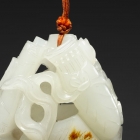J.J. Lally & Co., Oriental Art / New York City, New York
MenuPast Exhibition
ELEGANTLY MADE: Art for the Chinese Literati
March 13-27, 2020
6.
A RUSSET-FLECKED WHITE JADE ‘FOUR ARTS’ PENDANT
Qianlong Period (1736-1795)
well carved in openwork and varied relief depicting the ‘four arts of a scholar-gentleman’ (wenren ziyi 文人四藝) including a zither wrapped in silk (qin 琴), a chess board with two chess containers (qi 棋), bundles of books (shu 書), and ribbon-tied painting scrolls (hua 畫), the translucent white stone flecked with reddish-brown natural markings.
Height 1 3⁄4 inches (4.4 cm)
Provenance
From the Collection of the former President of the San Francisco Bridge Company, Barrett G. Hindes (1897-1964) of Ross, California, donated to the de Young Museum of Fine Arts in 1969 and deaccessioned by the Fine Arts Museum of San Francisco in 2009
Christie’s New York, Fine Chinese Ceramics and Works of Art: Including Jades from the Fine Arts Museum of San Francisco, 18-19 March 2009, lot 423
The importance of the ‘four arts’ in the life of the Chinese literati is succinctly described by Jacobsen in Appreciating China: Gifts from Ruth and Bruce Dayton, Minneapolis, 2002, p. 315, as follows:
“Chief among traditional literati pursuits were the ‘four arts’ of painting, calligraphy, chess, and playing the ch’in. Accomplishment in these art forms went beyond the requisites of social grace and focused on achieving a mastery of oneself. The control of brush and ink, based on years of practice and experience, allowed scholars to give visual expression to subtle thoughts and feelings. Similarly, knowledge of classical literature combined with the study of historic calligraphy greatly influenced personal writing styles. Mastery of the complex strategies required in chess developed an agile mind while underscoring the importance of the intellectual process. The attainment of even moderate skill in playing the seven-stringed ch’in instilled sensitivity, patience, and discipline and was seen as a symbol of enlightenment.”
清乾隆 褐斑白玉「四藝」墜飾 高 4.4 厘米
來源 加州 Ross 鎮,舊金山橋樑公司總裁 Barrett G. Hindes 舊藏,
1969 年捐贈舊金山笛洋美術館,2009 年由舊金山藝術博物館退藏
紐約佳士得 2009 年 3 月 18-19 日,拍品第 423 號
